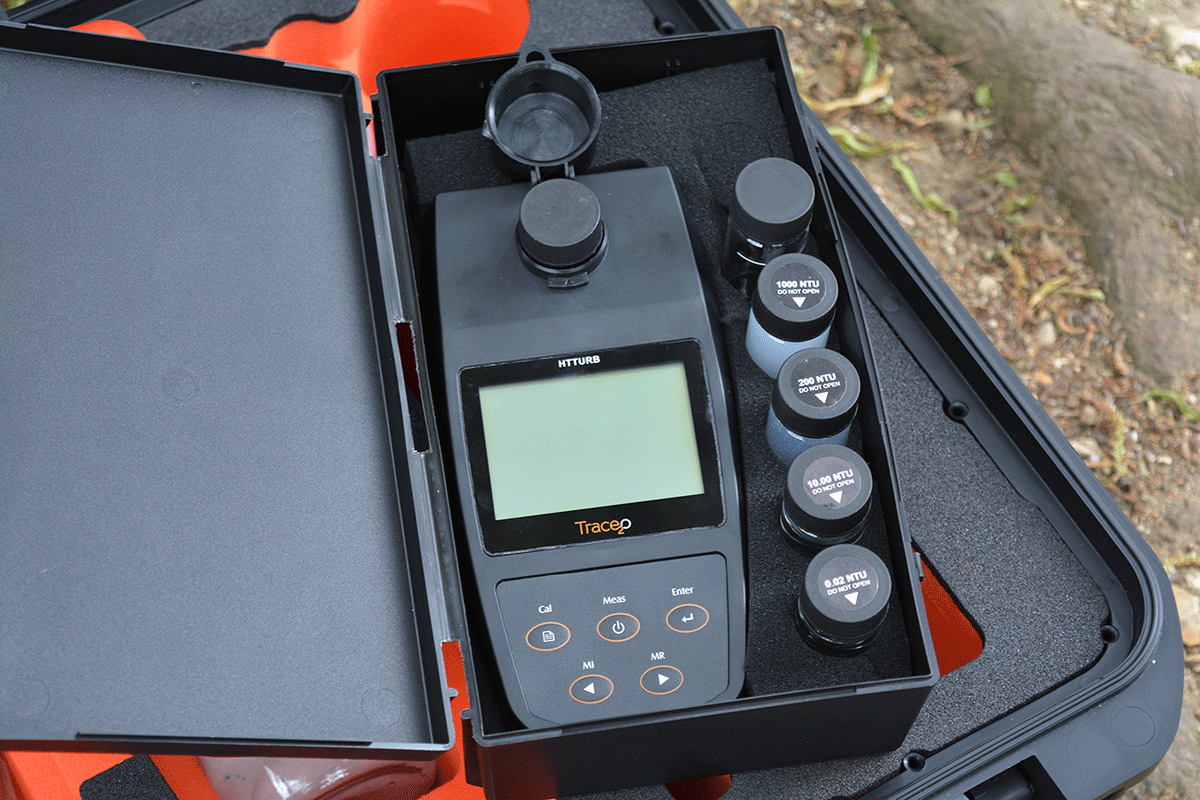S0005490
Turbidity Meter, Hand Held, 0-1000 NTU
Turbidity Meter, Hand Held, for digital measurement of water turbidity.
Measuring range from 0 to 1000 NTU or more.
Indicative Price USD 278.00
General Description:
Turbidity Meter, Hand Held, for digital measurement of water turbidity.
Measuring range from 0 to 1000 NTU or more.
Technical specifications:
Hand Held pocket size (Portable) Digital Turbidity Meter, allowing for digital measurement of water turbidity, in view of testing drinking water and raw water from rivers, canals, wells etc.
The Digital Turbidity Meter is supplied as an easy to hold, Hand Held and easily portable electronic instrument for use in rough field conditions. It is constructed in a strong waterproof case that meets the rigor of rugged field applications. The meter is used for instant water sample quality testing.
The Unit can measure Turbidity and preferably also total suspended solids (TSS).
The unit provides fast and reliable results within few seconds,
Turbidity measuring range of not less than 0-1000 NTU (potentially 0-2000 NTU).
Accuracy: ± 2.5% of reading or ± 0.01 NTU (0 - 500 NTU), or better.
The unit has:
- Large easy to read display,
- Preferably Integrated water-proof Sample Chamber for easy field use ,
- Light source emission at 850-860 nm wavelength,
- Light source: preferably LED or long-lasting Tungsten Filament Lamp equivalent type.
- Highly efficient light source for laboratory grade accuracy,
- Automatic push-button calibration (or equivalent),
- Automatic Range Selection (if operating with ranges),
- Preferably a variety of operating and reading modes including TSS, Average and Continuous Capture,
- IP67 Waterproof and Dustproof certified, including waterproof USB socket
- USB connectivity for power, recorder output, data download and software upgrades
- Designed for field use with result storage capacity and battery power for 10,000 tests or more.
- Battery/power saving features like Auto Shut Off.
- Power Supply: Alkaline or rechargeable batteries for field use and AC adapter for stationary use, or equivalent.
Standards:
-Supplier will provide potential CE conformity documentation (Industry standard nephelometric testing method: Fully compatible with EN ISO 7027, ensuring results are suitable for reporting to regulatory authorities)
-Supplier will provide potential Compliancy documentation with the requirements of the USEPA Method 180.1 for wastewater and Standard Method 2130 B for drinking water, and whether the instrument has an EPA compliance reading mode.
- Supplier will provide documentation whether the offered instrument incorporates complete GLP (Good Laboratory Practice) functions that allow traceability of the calibration conditions.
The kit is including:
Waterproof Turbidimeter (NTU) with necessary accessories, calibration kit, comprehensive operation manual & carrying case.
NOTE-1:
Any deviations to above specifications must be clearly indicated with the offer. Technical data sheet must be available and preferably provided together with the offer.
NOTE-2*):
Turbidity is usually measured in Nephelometric Turbidity Units (NTU) or Jackson turbidity units (JTU), depending on the method used for measurement. The two units are roughly equal.
Turbidity is the amount of cloudiness in the water. This can vary from a river full of mud and silt where it would be impossible to see through the water (high turbidity), to a spring water which appears to be completely clear (low turbidity). Turbidity can be caused by:
- silt, sand and mud;
- bacteria and other germs;
- chemical precipitates.
It is very important to measure the turbidity of domestic water supplies, as these supplies often undergo some type of water treatment which can be affected by turbidity. For example, during the rainy season when mud and silt are washed into rivers and streams, high turbidity can quickly block filters and stop them from working effectively. High turbidity will also fill tanks and pipes with mud and silt, and can damage valves and taps. Where chlorination of water is practiced, even quite low turbidity will prevent the chlorine killing the germs in the water efficiently.
Some treatment systems, such as sedimentors, coagulators and gravel pre-filters are designed to remove turbidity. It is important for operators of both large and small treatment systems to know how well these systems are working. Measuring the turbidity of the water before and after each part of the system can tell the operator where maintenance or cleaning is needed.
For drinking water and drinking water supplies, the following Turbidity Guidelines should be taken into consideration:
Drinking water should have a turbidity of 5 NTU/JTU or less.
Turbidity of more than 5 NTU/JTU would be noticed by users and may cause rejection of the supply.
Where water is chlorinated, turbidity should be less than 5 NTU/JTU and preferably less than 1 NTU/JTU for chlorination to be effective.
Turbidity can be measured using either an electronic turbidity meter or a turbidity tube.
Both methods have advantages and disadvantages, as per below:
(For the Turbidity Tube, please see corresponding UNICEF Material Code)
Advantages of the Turbidity Meter:
- very accurate, and especially useful for measuring very low turbidities (less than 5 NTU/JTU)
Disadvantages of the Turbidity Meter:
- higher cost, need power supply (mains or battery), and easily damaged - compared to visual tubes
INSTRUCTIONS:
Since digital instruments can be designed with varying designs, it is recommended that you refer to the instructions provided with the instrument that you are using (Please refer to manufacturers' instructions for use and maintenance of the actual meter).
Useful links
https://www.who.int/water_sanitation_health/hygie ne/emergencies/fs2_33.pdf
Alternative products:
Visual Turbidity Tube
Related Products


